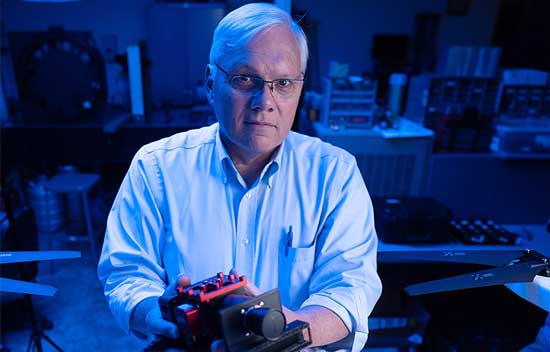mediaroom
UofM Secures $9.2M Navy Contract to Design Drone Facility
Withstanding Severe Weather is Goal of Research into Capabilities of Unmanned Vehicles
August 20, 2024 — Successfully flying a drone in heavy rains or on an extremely windy day is next to impossible. A University of Memphis researcher is looking to improve the odds for such unmanned aerial systems after securing a $9.2 million contract to design and construct a facility to develop and test drones capable of operating in adverse weather conditions.
The state-of-the-art facility is being sponsored by the Office of Naval Research and the Naval Surface Warfare Center – Carderock Division. The facility, which is still in its early planning stages, will be located on President’s Island at the William Morgan Large Cavitation Channel.
 The development of the Unmanned Systems Degraded Environment Facility underscores
the University of Memphis' commitment to advancing technological innovation and contributing
to national defense efforts.
The development of the Unmanned Systems Degraded Environment Facility underscores
the University of Memphis' commitment to advancing technological innovation and contributing
to national defense efforts.
"This project is the latest in an ongoing effort by the University of Memphis to develop intentional research-focused collaborations with the Naval Surface Warfare Center – Carderock,” said Cody Behles, executive director of research and innovation development at the UofM’s Division of Research & Innovation. “The Memphis Institute for National Defense Sciences at the UofM helps coordinate opportunities in partnership with the offices of the Tennessee Congressional Delegation. Their collaboration and continued support are vital to get projects such as this off the ground.”
The project is being led by Eddie Jacobs, senior researcher at the Center for Applied Earth Science and Engineering Research (CAESER) and professor of electrical and computer engineering in the Herff College of Engineering. The University of Memphis will collaborate with fellow researchers at the University of Arizona, the University of Central Florida and the University of Missouri-Kansas City.
“The William Morgan Large Cavitation Channel is already a unique facility for testing ship and submarine components,” said Jacobs. “We have the incredible opportunity to help build another unique facility for testing unmanned aerial systems (drones) in this space, greatly expanding the Navy’s ability to develop and test these systems.
“When flying drones, we are often restricted to days that have calm winds and no rain. We will be able to accurately control the wind and generate rain in this new facility,” Jacobs continued. “This will help us design and test drones that can operate under more challenging conditions.”
Jacobs highlighted the future research facility’s potential to enhance the performance of unmanned systems in difficult environments, with far-reaching implications for both military and civilian applications.
####
MEDIA CONTACT:
Jennifer Godwin
Director of Media and Public Relations
jennifer.godwin@memphis.edu
(O) 901.678.4822 (M) 501.529.7482
